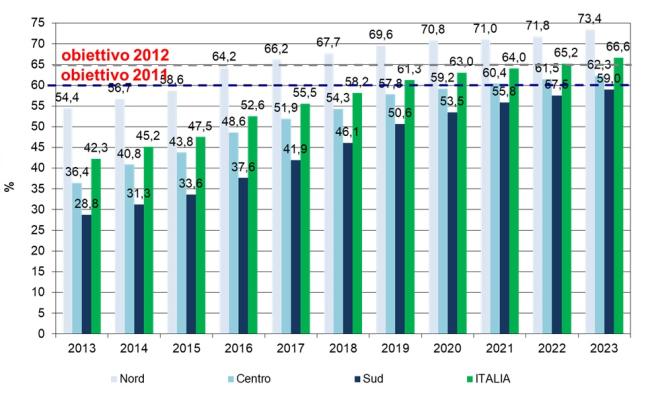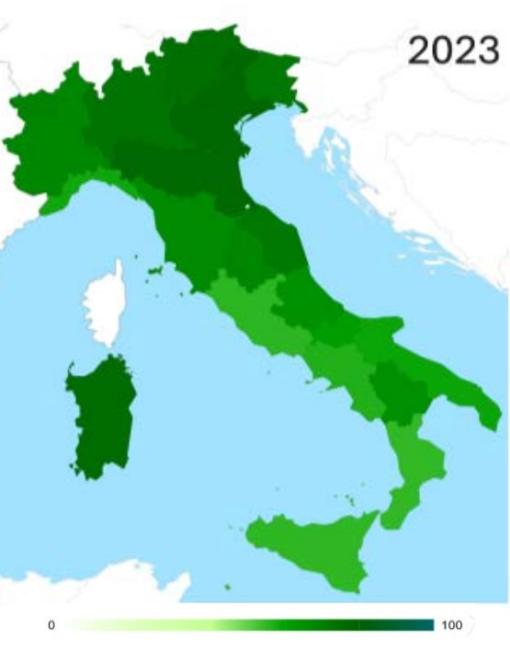Panel 1
Angelo Santini, Fabio Tatti
Nel 2023, la percentuale di raccolta differenziata è pari al 66,6% della produzione nazionale (29,3 milioni di tonnellate) (+1,4 punti percentuali rispetto al 2022), mantenendosi al di sopra dell’obiettivo fissato dalla normativa per il 2012 (65%).
This indicator measures the amount of municipal waste collected separately in the reference year relative to the total municipal waste production.
To assess compliance with the separate waste collection targets established by regulations.
The national legislation (Legislative Decree No. 152/2006, Law No. 296 of December 27, 2006) sets the following separate waste collection targets:
At least 35% by December 31, 2006
At least 40% by December 31, 2007
At least 45% by December 31, 2008
At least 50% by December 31, 2009
At least 60% by December 31, 2011
At least 65% by December 31, 2012
Panel 2
ISPRA - Rapporto Rifiuti Urbani (various editions)
Data quality assessment
ISPRA (Higher Institute for Environmental Protection and Research)
The data on the separate collection of municipal waste at the national, macro-regional, regional, provincial, and municipal levels are freely accessible and downloadable on the website www.catasto-rifiuti.isprambiente.it.
National, Regional
2007-2023
Indicator assessment
The indicator measures the amount of separately collected municipal waste in the reference year and calculates its percentage relative to total waste production. Specifically, ISPRA collects annual data on the separate collection of different waste fractions at the municipal level or, in some cases, at the level of Municipal Consortia, Mountain Communities, or Unions of Municipalities.
On May 26, 2016, the Ministry of the Environment issued a decree under Article 205, paragraph 3-quater of Legislative Decree No. 152 of April 3, 2006, containing guidelines for calculating the separate collection rate of municipal waste (published in the Official Gazette of the Italian Republic, General Series, No. 146 of June 24, 2016).
Since 2016, ISPRA has applied this methodology, which introduces some differences compared to the one used until 2015. From 2016 onwards, the methodology includes the following waste fractions in the calculation of unsorted waste:
-
Unsorted municipal waste (200301)
-
Street sweeping waste (200303) destined for disposal
-
Other unsorted municipal waste (200399)
-
Bulky waste (200307) not destined for recovery (counted separately, contributing to total waste production but not to separate collection data).
The following waste types are included in separate collection:
-
Organic fraction (food and green waste), including household composting waste
-
Packaging waste, including multi-material collection with residues (i.e., the collection of different categories of municipal waste using a single container), as well as paper, cardboard, plastic, wood, metal, and glass waste classified under Chapter 20 of the European Waste List
-
Bulky waste sent for recovery (200307)
-
Textile waste
-
Selective collection waste (medications, T/FC containers, batteries and accumulators, paints, inks, adhesives, vegetable and mineral oils, etc.)
-
Waste Electrical and Electronic Equipment (WEEE)
-
Construction and Demolition (C&D) waste (limited to codes 170107 and 170904 from small-scale removal work conducted directly by household residents)
-
Street sweeping waste sent for recovery (200303)
-
Other separately collected fractions
C&D waste, as per guidelines from the Ministry of the Environment, is accounted for in separate collection and waste production up to a threshold of 15 kg per capita per year. Similarly, a threshold has been set for domestic composting waste contributing to the organic fraction separate collection rate, set at 80 kg per capita per year.
For street sweeping waste, in compliance with the decree of May 26, 2016, ISPRA includes only the portion sent for recovery in the separate collection rate. If there is no clear information on the waste’s destination, or if only a storage operation (R13) is recorded without further details on actual recovery, the quantity is classified as unsorted waste.
The target set by legislation for 2012 (65%) was exceeded once again at the national level in 2023, with a separate collection rate of 66.6% (Table 1 and Figure 1).
Separate collection has been steadily increasing across all areas of the country. Between 2014 and 2023, the national separate collection rate rose by more than 21 percentage points (Figure 1).
Data
Table 1: Amount of municipal waste collected through separate collection and percentage of total waste collected
ISPRA


In 2023, the percentage of separate collection reached 66.6% of national municipal waste generation (29.3 million tonnes), marking an increase of 1.4 percentage points compared to 2022. In terms of absolute quantities, the North accounted for nearly 10.4 million tonnes of separately collected waste, the Center for just under 3.9 million tonnes, and the South for approximately 5.2 million tonnes. These figures correspond to regional separate collection rates—calculated as a share of total municipal waste generated within each macro-area—of 73.4% for Northern regions, 62.3% for Central regions, and 58.9% for Southern regions (Figure 1).
Compared to 2022, all macro-geographical areas recorded increases in separate collection rates: the North grew by 1.6 percentage points, the South by 1.4 points, and the Center by 0.8 points.
At the regional level, Veneto once again recorded the highest separate collection rate, at 77.7%, followed by Emilia-Romagna (77.1%), Sardinia (76.3%), Trentino-Alto Adige (75.3%), Lombardy (73.9%), and Friuli-Venezia Giulia (72.5%). Among these, Friuli-Venezia Giulia and Emilia-Romagna posted the most significant improvements compared to 2022, with increases of 5 and 3.1 percentage points, respectively. Emilia-Romagna also surpassed Sardinia and Trentino-Alto Adige in 2023, closely approaching Veneto’s leading value.
Several other regions also exceeded the 65% target set by legislation for 2012, including Marche (72.2%), Aosta Valley (69.4%), Umbria (68.8%), Piedmont (67.9%), and Tuscany (66.6%). Basilicata (64.9%) and Abruzzo (64.6%) were near the target. Overall, 11 regions recorded separate collection rates equal to or above the national average (66.6%).
Molise and Apulia reported rates of 60.8% and 59.0%, respectively, while Liguria stood at 58.3%. Campania reached 56.6%, Lazio 55.4%, Sicily 55.2%, and Calabria 54.8%. Notably, Sicily showed a significant improvement: a 3.8-point increase over 2022 (51.5%), nearly 8 points compared to 2021, 13 points over 2020, and just under 17 percentage points compared to 2019. As a result, Sicily surpassed Calabria and nearly closed the gap with Lazio (Table 1 and Figure 2).